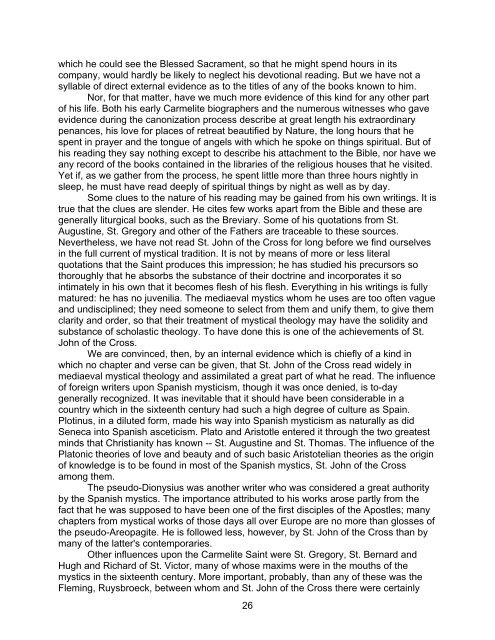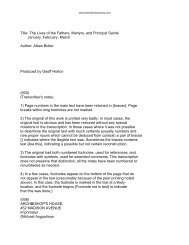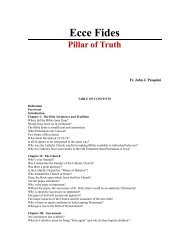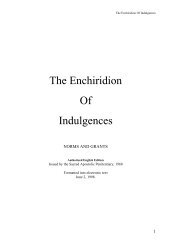Ascent of Mt. Carmel - St. Patrick's Basilica
Ascent of Mt. Carmel - St. Patrick's Basilica
Ascent of Mt. Carmel - St. Patrick's Basilica
You also want an ePaper? Increase the reach of your titles
YUMPU automatically turns print PDFs into web optimized ePapers that Google loves.
which he could see the Blessed Sacrament, so that he might spend hours in its<br />
company, would hardly be likely to neglect his devotional reading. But we have not a<br />
syllable <strong>of</strong> direct external evidence as to the titles <strong>of</strong> any <strong>of</strong> the books known to him.<br />
Nor, for that matter, have we much more evidence <strong>of</strong> this kind for any other part<br />
<strong>of</strong> his life. Both his early <strong>Carmel</strong>ite biographers and the numerous witnesses who gave<br />
evidence during the canonization process describe at great length his extraordinary<br />
penances, his love for places <strong>of</strong> retreat beautified by Nature, the long hours that he<br />
spent in prayer and the tongue <strong>of</strong> angels with which he spoke on things spiritual. But <strong>of</strong><br />
his reading they say nothing except to describe his attachment to the Bible, nor have we<br />
any record <strong>of</strong> the books contained in the libraries <strong>of</strong> the religious houses that he visited.<br />
Yet if, as we gather from the process, he spent little more than three hours nightly in<br />
sleep, he must have read deeply <strong>of</strong> spiritual things by night as well as by day.<br />
Some clues to the nature <strong>of</strong> his reading may be gained from his own writings. It is<br />
true that the clues are slender. He cites few works apart from the Bible and these are<br />
generally liturgical books, such as the Breviary. Some <strong>of</strong> his quotations from <strong>St</strong>.<br />
Augustine, <strong>St</strong>. Gregory and other <strong>of</strong> the Fathers are traceable to these sources.<br />
Nevertheless, we have not read <strong>St</strong>. John <strong>of</strong> the Cross for long before we find ourselves<br />
in the full current <strong>of</strong> mystical tradition. It is not by means <strong>of</strong> more or less literal<br />
quotations that the Saint produces this impression; he has studied his precursors so<br />
thoroughly that he absorbs the substance <strong>of</strong> their doctrine and incorporates it so<br />
intimately in his own that it becomes flesh <strong>of</strong> his flesh. Everything in his writings is fully<br />
matured: he has no juvenilia. The mediaeval mystics whom he uses are too <strong>of</strong>ten vague<br />
and undisciplined; they need someone to select from them and unify them, to give them<br />
clarity and order, so that their treatment <strong>of</strong> mystical theology may have the solidity and<br />
substance <strong>of</strong> scholastic theology. To have done this is one <strong>of</strong> the achievements <strong>of</strong> <strong>St</strong>.<br />
John <strong>of</strong> the Cross.<br />
We are convinced, then, by an internal evidence which is chiefly <strong>of</strong> a kind in<br />
which no chapter and verse can be given, that <strong>St</strong>. John <strong>of</strong> the Cross read widely in<br />
mediaeval mystical theology and assimilated a great part <strong>of</strong> what he read. The influence<br />
<strong>of</strong> foreign writers upon Spanish mysticism, though it was once denied, is to-day<br />
generally recognized. It was inevitable that it should have been considerable in a<br />
country which in the sixteenth century had such a high degree <strong>of</strong> culture as Spain.<br />
Plotinus, in a diluted form, made his way into Spanish mysticism as naturally as did<br />
Seneca into Spanish asceticism. Plato and Aristotle entered it through the two greatest<br />
minds that Christianity has known -- <strong>St</strong>. Augustine and <strong>St</strong>. Thomas. The influence <strong>of</strong> the<br />
Platonic theories <strong>of</strong> love and beauty and <strong>of</strong> such basic Aristotelian theories as the origin<br />
<strong>of</strong> knowledge is to be found in most <strong>of</strong> the Spanish mystics, <strong>St</strong>. John <strong>of</strong> the Cross<br />
among them.<br />
The pseudo-Dionysius was another writer who was considered a great authority<br />
by the Spanish mystics. The importance attributed to his works arose partly from the<br />
fact that he was supposed to have been one <strong>of</strong> the first disciples <strong>of</strong> the Apostles; many<br />
chapters from mystical works <strong>of</strong> those days all over Europe are no more than glosses <strong>of</strong><br />
the pseudo-Areopagite. He is followed less, however, by <strong>St</strong>. John <strong>of</strong> the Cross than by<br />
many <strong>of</strong> the latter's contemporaries.<br />
Other influences upon the <strong>Carmel</strong>ite Saint were <strong>St</strong>. Gregory, <strong>St</strong>. Bernard and<br />
Hugh and Richard <strong>of</strong> <strong>St</strong>. Victor, many <strong>of</strong> whose maxims were in the mouths <strong>of</strong> the<br />
mystics in the sixteenth century. More important, probably, than any <strong>of</strong> these was the<br />
Fleming, Ruysbroeck, between whom and <strong>St</strong>. John <strong>of</strong> the Cross there were certainly<br />
26






